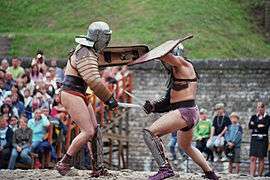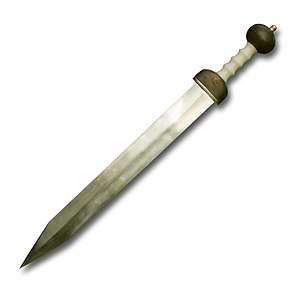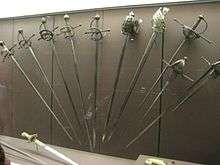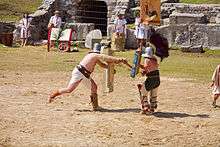Italian martial arts
Italian martial arts is the use of weapons (swords, daggers, walking stick and staff). Each weapon is the product of a specific historical era. The swords used in Italian martial arts range from the gladius of the Roman legionaries to swords which were developed during the renaissance, the baroque era and later. Short blades range from medieval daggers to the liccasapuni Sicilian duelling knife.
Characteristics of Italian combat styles
A trademark of the Italian styles of fence is the emphasis on the point over cutting, which has been stressed since the time of the Roman legions: the legionaries used to laugh at enemies who cut or slashed with their swords. The base of most Italian Systems is fencing and many methods of stick fighting use the same techniques and movements used when fencing with swords. Therefore, if a practitioner trains with the stick or baton, he would also become proficient with the sword. Examples of this are Canne Italiana which uses the moves and techniques of the duelling sabre (sciabola da terreno) and Bastone Italiano, where the moves comes from fencing with the two-handed sword (Spadone a Due Mani). Most methods have one thing in common: practitioners don protective sport fencing masks and padded clothing and practice with blunt training blades, since live sparring is of critical importance in the training routine. A very important characteristics of Italian Martial Arts is that they originated from battlefield or gladiatorial combat experience. They were not created by monks but by soldiers and there is no religious or spiritual influence in their practice. Furthermore, each school/style often is associated with specific historical periods or events, including battles.
The main historical periods that influenced the development of Italian weapons were:
Ancient Rome
Gladiatorial Combat was a popular spectator bloodsport in Roman times. Gladiators were trained in special schools and were armed according to the Roman standard or like some of Rome's enemies. This allowed for experimentation with different weapons and styles of combat. Some of the weapons were unusual, such as the net used by the Retiarius.
Roman writers described methods and techniques for training and using the gladius, for example Vegetius in his De Re Militari. Thanks to this wealth of information the art of gladiatorial combat has been resurrected and the discipline of “Gladiatura Moderna” is now being practiced by numerous practitioners.


Renaissance and Baroque eras
The Renaissance (14th to 17th century AD) saw frequent warfare on Italian soil and mercenary armies were formed by the Condottieri, refining and improving weapons and techniques. One soldier of fortune, Master Fiore dei Liberi wrote a manual Flos Duellatorum or "the Flower of Battle" in 1410, illustrating a repertoire of techniques for many different weapons and for unarmed combat, and thus originated the Italian school of swordsmanship. After Fiore, the Italian school of swordsmanship was continued by Filippo Vadi (1482–1487) and Pietro Monte (1492).
Battlefield Experience
The techniques and skills taught by the Italian school were successfully tested against the Landsknecht and the Swiss Pikemen, regarded as the finest infantries of the time, and also against the French Knights, who represented the flower of European Cavalry. Example of such engagements were
- The Battle of Arbedo in 1422.
- The battle of Calliano in 1487.
- The Battle of Ravenna in 1512.
- The Challenge of Barletta in 1503. In this tournament 13 Italian knights faced and defeated 13 French knights in hand-to-hand combat.[1]
- The forces led by Giovanni dalle bande nere fighting against the Landsknecht in a number of small battles in 1527.
- The battle of Marignano in which Gian Giacomo Trivulzio earned the rank of Marshal of France, an honor conferred to few foreigners. The utter defeat at Marignano was one of the events that transformed Swiss policy from one of military aggression to one of neutrality.

These battlefield experiences influence a number of masters at arms, including Antonio Manciolino, Angelo Viggiani, Achille Marozzo, Camillo Agrippa, Giacomo Di Grassi, Giovanni Dall'Agocchie, Henry de Sainct-Didier, Frederico Ghisliero and Vincentio Saviolo

The Thirty Years War
When the era of the Condottieri came to a close on Italian soil, military commanders like Ottavio Piccolomini and Raimondo Montecuccoli placed their soldiers at the disposal of the Austrian Emperor, in a war of religion that devastated Germany and caused the loss of 30% of its people, perhaps the greatest tragedy ever endured by Germany. Italian forces fought valiantly (albeit on the losing side) at the Battle of Lutzen and helped win a great victory at the Battle of Nordlingen in 1634 against the Swedes. Ambrogio Spinola and his men meanwhile helped Spain to conquer the Netherlands in battles like the Siege of Breda. This war was perhaps the last one were swords, daggers and pikes played an important role in battle as firearms technology was now becoming more reliable. Italian swordsmen, armed with short swords and daggers were extremely effective at infiltrating the pike squares of their adversaries and at bringing down the defenseless pikemen armed with the long pikes during the brutal push of the pikes. On the battlefield the so-called "Spada da Lato" or side-sword became the dominant sword type. At the same time in the cities of Italy the sidesword evolved into a new type of sword, used in a civilian setting for duelling. This civilian sword is known as "La Striscia" or Rapier in English. Frenchmen adopted the Italian duelling sword and mastered it, and it is believed that between 1600 AD and 1700 AD well over 70,000 Frenchmen died in duels, many of them mortally wounded by a Rapier. From the late 16th century, Italian rapier fencing attained considerable popularity all over Europe, notably with the treatise by Salvator Fabris whose De lo schermo overo scienza d’arme of 1606 exerted great influence not only in Italy but also in Germany. Fabris was followed by Italian masters such as Nicoletto Giganti (1606), Ridolfo Capo Ferro (1610), Francesco Alfieri (1640), Francesco Antonio Marcelli (1686) and Bondi' di Mazo (1696).

The Napoleonic Wars
Napoleon, being himself of Italian origin, added Northern Italy to his domains and was crowned King of Italy using the Iron Crown of Lombardy, a very symbolic gesture since the Bonaparte family had distant Lombard origins. When Napoleon invaded Russia in 1812, he took with him a 50,000-strong Italian contingent. The Italian troops were instrumental in the French victory at the Battle of Maloyaroslavets and were praised by Napoleon. It was during these times that the art of "Scherma da Terreno" (field fencing) was developed, using as weapons swords and sabres.[2] The sabre, in particular, was developed in a dueling art with the school of Sciabola da terreno.[3]
World Wars
World War I During World War I the Italian army created a unit of assault troops called Arditi whose task was to storm German and Austrian Trenches. The main weapon of these soldiers was the dagger and 18,000 arditi were trained and sent to the front. Arditi units won numerous engagements against Austrian and German troops in the final year of World War I, armed with daggers which proved very effective in the confined space of a trench, where rifles were too long to be used in close combat. General Rommel wrote about the exploits of the Arditi in the very last page of his book "Infanterie greif an" (Infantry attacks). The successful attack on Col Moschin was a perfect example of Arditi tactics.
World War II The second battle of El-Alamein pitted the Italian paratroopers of the 185 Airborne Division Folgore with no tanks and only a few antitank guns (whose shells failed to penetrate the armor of British tanks) against one British armored division equipped with 400 heavy tanks. During the first assault 70 British tanks were destroyed by the folgore soldiers, using almost exclusively improvised sticky charges as their anti-tank weapons had proven worthless against British armor. After several days 208 tanks were destroyed in this way. While techniques to destroy armored vehicles are not typically part of martial arts instruction programs, given the exploits of "Folgore", they could be considered a key part of Italian Martial Arts. It does not therefore come as a surprise that the Italian Army has developed a hand-to-hand system known as Metodo di Combattimento Militare and that the 187th Paratrooper Regiment of Folgore Brigade has played a leading role in developing this system.

Modern Italian Elite Units
Several Italian Elite military or police units have developed their own armed and unarmed combat systems. The Navy's Arditi Incursori of COMSUBIN have developed a system, but little information is known about it. From available video footage[4] it appears that it blends techniques from martial arts such as judo, jiu jitsu and kickboxing, resembling "Kick Jitsu" (see later). The Incursori train in full combat gear, including firearms. The Carabinieri elite intervention unit, Gruppo di intervento speciale has also developed an armed/unarmed combat system. From a documentary] released on Italian TV[5] it appears that the unit blended techniques from Judo, Karate, Wu-Shu, Savate, Full-contact kickboxing and Muay Thai to create their own system. The GIS operators also adopt a form of Functional training to keep in shape. Perhaps the best known operation involving the use of martial arts is the one carried out in the 1980s by the Nucleo Operativo Centrale di Sicurezza also known as NOCS. It is well known that an operator of NOCS dispatched one of the kidnappers of US general James L. Dozier with a karate chop during the rescue.[6] NOCS is rumored to have had Olympic-level athletes amongst its ranks, particularly in combat sports and weight-lifting. To this day NOCS maintains a working relationship with the Italian federation of Weightlifting.[7] There is no information on what martial arts system is actually used by the NOCS unit,and it is quite possible that this police unit devised its own combat method. Most law enforcements agencies in Italy have adopted a system called Metodo globale di autodifesa or MGA[8] which is a compilation of techniques derived from various martial arts and which has been approved by the Federazione Italiana Judo Lotta Karate Arti Marziali (FIJLKAM).
The evolution of martial arts training in elite units
Elite military and police units tend to integrate firearms (and firearms retention) into their training and techniques so that firearm handling is itself turning into a martial art. After all, if knife and baton are the subject of martial arts training, why not firearms? A new breed of "Master at arms",which were former elite unit operators are providing instruction in firearm handling. This is in keeping with the Italian tradition of the Maestri D'Arme, when former knights and soldiers became weapons instructors in their late years (Fiore dei Liberi da Premariacco is a prime example of this).
Regional styles and schools
Sicily
1) In Sicily an organization called Liu-bo has codified the techniques of traditional Sicilian Staff Fighting known as "Paranza Lunga" and now organizes competitions at the regional level. This school is rapidly expanding. "Paranza Lunga" started around AD 1200 as a method of self-defense for shepherds. The staff was the weapon of the poor, who could not afford a sword. The staff was used in a whirling overhead motion, mimicking the way a knight would use a two-handed sword. Initially there was no established technique and the use of the staff was simply based on the imitation of the use of the sword. By AD 1600, however,separate schools of staff fighting had emerged. A few such schools, or styles, survive to this day. These are "Cavalleresca", "Fiorata", "Battuta", "Ruotata" and "Giocata". "Giocata" is the only style that uses a single hand to operate the staff, while all the other styles use both hands. The staff is about 120 cm long and is made of hard wood, usually from Orange or Pear trees, or from Rosella or Ulivastro trees.[9]
2) Paranza Corta (Sicilian Knife Fighting) is the traditional knife fighting style of Sicily. It is still taught by individual masters but is not organized in a format suitable for divulgation to the masses. Those who wish to learn the art have to seek out the individual masters and be accepted as students. The weapon used is a folding stiletto knife which come in a few variants, the most famous being the Liccasapuni (literally "soap licker" because the blade used to be smeared with soap before a duel, so that it would cause permanent scars on the recipient of a cut). The Sicilian style is further subdivided into two branches: the school of Palermo and that of Catania.
Sardinia
Istrumpa, the wrestling style of Sardinia is also growing in popularity. The association promoting this sport is participating in European championships for Celtic wrestling stiles (such as Gouren), which has showcased the skills of Istrumpa wrestlers.
Genoa
In recent years the discipline of Bastone Genovese has begun to be taught in specialized gyms in the region of Liguria, where it had originated centuries ago.[10]
Naples
Bastone Napoletano is the newest stick fighting discipline to come to the limelight in Italy.[11] Like many other regional styles it has been in existence for centuries but was formerly taught by individual masters on a one on one basis. The discipline is also known as "Varra" and uses a long stick of 1.60 meters.
Other regions
Several other regional styles of knife and stick fighting remain in existence. These are kept alive by individual Masters at Arms who teach their techniques privately. Amongst the knife styles we should mention the styles of Rome, Neaples, Salerno, Calabria and Corsica (which nowadays is a French region). Disciplines focusing on staff fighting include, Bastone Calabrese (Calabrian Stick Fighting), Bastone Milanese, Bastone Piemontese, Taccaro and Bordone
Modern Italian styles
Canne Italiana
The Manusardi family from Milan modified, three generations ago, the French art of Canne de combat and created Canne Italiana.[12] According to Italo Manusardi the French style sacrificed power to achieve speed. Canne italiana is slower than the French style but more powerful in its blows. Most moves and techniques are similar to those used in the handling of the dueling sabre (Sciabola da Terreno) hence Canne Italiana represents useful training for those interested in the dueling sabre. The Manusardi gym also teaches "Bastone Italiano" a form of staff fighting similar to Baton francais.
Gladiatura Moderna
The group "Ars Dimicandi" teaches Gladiatorial combat in the style of ancient Rome.[13] This group has led a meticulous research on gladiatorial combats. Other schools which teach the same art are Scuola Gladiatori Sacrofano and Ludus Magnus.
JuJitsu, Bianchi Method
Gino Bianchi, a savate expert from Genoa, was stationed in Tianjin, China, during World War II as part of an Italian military mission and learnt Jujitsu from Japanese practitioners. Maestro Bianchi eventually returned to Italy and developed a Jiujitsu method using what he had learnt from the Japanese and also by adding techniques that he developed himself. He published a book describing his method, which he said was “adapted for Westerners”. This Jujitsu system, known as "Metodo Bianchi" (Bianchi Method) became quite popular in Italy and is still thriving today.[14]
Kick Jitsu
Kick Jitsu is the name of a modern combat sport part of the FIKBMS, the Italian federation of kickboxing recognized by CONI. Born in the 1980s through the merger of the techniques and methods of kickboxing and those of jujitsu, the kick jitsu or kickjitsu is regulated in Italy by FIKBMS through a national technical committee that is chaired by Patrizio Rizzoli, who also plays the role of director and national coach. In Italy, the discipline is widespread, especially in Tuscany, Liguria and Calabria. In 2003 the World Kick-Jitsu Federation was founded, which changed its name to World Mixed Martial Arts Federation in 2012 and which now counts organizations from 20 different countries amongst its members.
Nova Scrimia
In Italy, UK, USA and Mexico, one of the main organization teaching Italian Martial Arts from the documented period that goes from the 15th century to the 20th century is Nova Scrimia. Nova Scrimia promotes the teaching of the Italian School of Fencing and Swordsmanship, starting as described by Fiore dei Liberi in his 1410 treatise Flos Duellatorum in Armis et sine Armis, also known as "Fior di Battaglia" (The flower of Battle), and followed by either the rich and uninterrupted literature of Italian fencing, and by the direct teachings and lineage of the Italian fencing Masters of dueling, self-defense and sport combat fencing methods and schools (swords, sticks, daggers/knives, unarmed).
The curriculum is divided into modern methods and historical schools, both are studied and practiced for contemporary applications and current use in competitive fighting, dueling and defense. The methods include the use of medieval and renaissance swords, one and half hand sword (spada una mano e mezzo), side sword (spada da lato), the rapier (la striscia), the duelling sabre (spada e sciabola da duello o da terreno), venetian and bolognese dagger styles, short range fencing, different staff and stick fighting methods, Venetian Cornoler stick fighting and hand-to-hand combat (based on grappling and striking methods, ancient boxing and wrestling methods and free hand fencing). All these fencing methods are always characterized to be a "scherma accompagnata", meaning a kind of fencing that always actively uses both hands, with or without a weapon (sword and dagger, two swords, sword and buckler, sword and cape, dagger and cape, two sticks, two daggers, etc.) and in any case it always makes use of the unarmed hand in an active fencing strategy, as if it is a second weapon, a typical characteristic of the Italian school of fencing. All methods, united by the same framework of the art and science of fencing, are practiced for combat and for self-defense.
Nova Scrimia is a research group that started unofficially in 1990 and was founded officially in 1999 in Italy. The founder group (or brotherhood) was enriched over time by experts, professionals and passionate people with different expertise: academic, scientific or historical background and curricula; people who brought and contributed with different Italian fencing traditions, people with solid different martial art curricula. Nova Scrimia Research Group is a collective and collegial work developed to preserve, protect, promote and actualize the Italian Martial Art tradition. Nova Scrimia Italian Martial Art school is based on: preserving the specific fencing principles (like geometry, anatomy and physics); following the science of fencing evolved in Italy and the efficacy of the Art collected and transmitted by the teaching over centuries of experience in duels and battles; maintaining the specific Italian attitude and culture of the dueling and of the fighting that characterize the Art; and finally adapting, at the same time, to the needs, knowledge, culture and technology of the present time.
Sistema Scrima
Professor G.G. Merendoni has created a style of military combat known as Sistema Scrima (evolved from a prior system called Sistema SAL) inspired by the Arditi of the first world war and incorporating techniques from historical fencing and regional styles. Alpini mountain troops units dispatched to Afghanistan in recent years were trained by the Merendoni school.
Other organizations teaching Italian swordsmanship
The Federazione Italiana Scherma Antica E Storica or FISAS teaches the skills of the Italian School of Swordsmanship.[15] The largest organization is Sala D'Arme Achille Marozzo which counts more than 30 Sale D'Armi (armed instruction centers) and more than 700 students spread over northern and central Italy and organizes the biggest championships at national level for Renaissance and Medieval swordsmanship.[16] Since 1998, Sala d'Arme Achille Marozzo[17] organizes every year a great championship in Italy. Due to the excessive number of participants, in 2011 this competitive event was split in two separate events: military weapons (in autumn) and civil weapons (in spring), extending the organization in a larger coalition of Italian HEMA club. Civilian weapons include single sword, sword and cape, sword and dagger, and sword and Brocchiero (Buckler). The military weapons are the two-handed sword, spear, shield and spear, sword and targe, and sword and wheel. The civil weapons championship is currently the largest HEMA tournament in the world.[18] In the United States the Chicago Swordplay Guild is the leading organization teaching and researching Italian martial arts according to the dei Liberi and Fabris Schools. The Association for Renaissance Martial Arts teaches rapier fencing and has done much to reconstruct rapier combat techniques from the historical manuals of the Italian masters of this art. In England Schola Gladiatoria is an active organization which has done much research and is one of the prominent schools in Europe for Italian martial arts.
References
- "ettore fieramosca 6-6.wmv". YouTube. 2011-12-20. Retrieved 2016-06-02.
- "Scherma Da Teereno" (PDF). Stratosbari.it. Retrieved 2016-06-02.
- "Sciabola | ASD FISAS - Scherma Tradizionale". Scherma-antica.org (in Italian). Retrieved 2016-06-02.
- Comando Subacquei Incursori - Com.Sub.In - Gruppo operativo Incursori - Marina Militare FULL HD. 23 February 2013 – via YouTube.
- Muay Thai e Functional Training presso il GIS dei Carabinieri!!!. 18 October 2013 – via YouTube.
- "Concluso il Corso di formazione FIPE per agenti speciali NOCS | Federpesistica - 2015". Federpesistica.it. Retrieved 2016-06-02.
- "Metodo Globale Autodifesa, MGA System - MGA system - Metodo Globale di Autodifesa". Mgasystem.eu. Retrieved 2016-06-02.
- "La storia dell'Associazione Nazionale Bastone Siciliano". Associazione Nazionale Bastone Siciliano.
- "Genoa Walking Stick and Staff Combat - Official Web Site". Bastonegenovese.gipoco.com. Retrieved 2016-06-02.
- "Archived copy". Archived from the original on January 2, 2014. Retrieved June 24, 2012.CS1 maint: archived copy as title (link)
- "Canne italiana". Schermamanusardi. Retrieved 2016-06-02.
- "copertina arsdimicandi". Arsdimicandi.net. Retrieved 2016-06-02.
- "Metodo Bianchi". Jujitsu-aijj.it. Retrieved 2016-06-02.
- "Home | ASD FISAS - Scherma Tradizionale". Scherma-antica.org (in Italian). Archived from the original on 2016-02-02. Retrieved 2016-06-02.
- "Arti Marziali Storiche Europee - Sala d'Arme Achille Marozzo". Sala d'Arme Achille Marozzo.
- "Sala d'Arme Achille Marozzo - Associazione culturale e sportiva". Achillemarozzo.it. Retrieved 2015-07-10.
- "2014 – VI° Torneo Nazionale di Scherma Antica UISP – Discipline Civili". Achillemarozzo.it. Retrieved 2015-07-10.
Sources
- Grant, Michael (2000). Gladiators. London, United Kingdom: Penguin Books. ISBN 0-14-029934-3.CS1 maint: ref=harv (link)
- Wiedemann, Thomas (1992). Emperors and Gladiators. London, United Kingdom: Routledge. ISBN 0-415-12164-7.CS1 maint: ref=harv (link)
- Wisdom, Stephen; McBride, Angus (2001). Gladiators: 100 BC - AD 200. Oxford, United Kingdom: Osprey Publishing. ISBN 1-84176-299-7.CS1 maint: ref=harv (link)
- Anglo, Sydney. The Martial arts of Renaissance Europe. Yale University Press, 2000. ISBN 0-300-08352-1
- John Clements, Medieval Swordsmanship: Illustrated Methods and Techniques. Paladin Press, 1998). ISBN 1-58160-004-6
- John Clements, Renaissance Swordsmanship : The Illustrated Book Of Rapiers And Cut And Thrust Swords And Their Use. Paladin Press, 1997. ISBN 0-87364-919-2
- John Clements, et al. Masters of Medieval and Renaissance Martial Arts: Rediscovering The Western Combat Heritage. Paladin Press, 2008. ISBN 978-1-58160-668-3
- Gaugler, William. The History of Fencing : Foundations of Modern European Fencing. Laureate Press, 1997. ISBN 1-884528-16-3
- Italian Arditi: Elite Assault Troops 1917-20. Osprey; Paperback; March 2004; 64 pages; ISBN 978-1-84176-686-7
- Arnold, Thomas F. The Renaissance at War. Smithsonian History of Warfare, edited by John Keegan. New York: Smithsonian Books / Collins, 2006. ISBN 0-06-089195-5.
- Baumgartner, Frederic J. Louis XII. New York: St. Martin's Press, 1994. ISBN 0-312-12072-9.
- Black, Jeremy. "Dynasty Forged by Fire." MHQ: The Quarterly Journal of Military History 18, no. 3 (Spring 2006): 34–43. ISSN 1040-5992.
- European Warfare, 1494–1660. Warfare and History, edited by Jeremy Black. London: Routledge, 2002. ISBN 0-415-27532-6.
- Guicciardini, Francesco. The History of Italy. Translated by Sydney Alexander. Princeton: Princeton University Press, 1984. ISBN 0-691-00800-0.
- Hall, Bert S. Weapons and Warfare in Renaissance Europe: Gunpowder, Technology, and Tactics. Baltimore: Johns Hopkins University Press, 1997. ISBN 0-8018-5531-4.
- Simonis, Damien; et al. (January 2004). Lonely Planet's Italy (6th ed.). Lonely Planet Publications. p. 659. ISBN 1-74104-303-4.
- The Sicilian Blade ISBN 978-0-87947-160-6 Author: Vito Quattrocchi
- Miller & G.A. Embleton, "The Swiss at War 1300-1500", Men At Arms 094, Osprey Publishing (1979)
- Erwin Rommel, Infantry Attacks, Zenith Press 2009, ISBN 0-7603-3715-2
